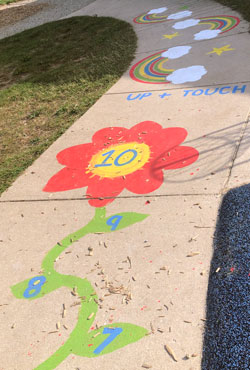“Can you slither like a snake for me?” occupational therapist Meghan Warner asked Finnley Rahe and William Chisholm, students in Tammy Genne’s Young 5’s program.
“How about tiptoeing down this path?” she asked.
Happily for Finnley and William, they were able to do just that. They and other students at Duncan Lake Early Childhood Center get the chance to slither like a snake, tiptoe and even hop down the hallways every day, thanks to sensory paths snaking through and outside their preschool.

At Duncan Lake ECC, as at other schools locally and nationally, teachers find the sensory paths help students focus more calmly in the classroom by hopping and slithering outside of it.
Last year, a video showcasing students in Oxford, Mississippi utilizing sensory paths in their school’s hallway went viral. The video, posted by special education teacher Holly Clay, generated more than 42 million views, attracting the attention of Caledonia occupational therapists Warner and Michelle Cullin.
“When we saw the video we knew that that was something that we needed at our school,” Warner said.
After receiving a grant last year from the Caledonia Education Foundation for $687.87, Warner, Cullin and two occupational therapy fieldwork students from Grand Valley State University set out to make their own indoor and outdoor sensory paths. The grant went toward vinyl, cutting mats, blades, paint, stencils, brushes and plastic floor runners.
Each path contains imagery of core vocabulary, basic colors, letter recognition and the school’s mascot, “The Ducks.” In between class time, teachers take their students through the paths, instructing them on how to follow the directions on the mats.
“We wanted to make them relatable to the students and the community that would be using them,” Warner said. “That’s why in some stations, students are prompted to waddle like a duck, our school mascot.”

Releasing ‘Built-up Energy’
Differing from the sensory room currently at the Early Childhood Center, the path allowed for an entire class to take advantage of the sensory outlet at once.
“What we found was that teachers could take their whole classes through the paths and it created a nice break for students between sessions,” she said.
Indeed, preschool special education teacher Candi Harper says, the paths give her students a much needed break throughout the day.
“Many of my kiddos struggle sitting for more than a few minutes at a time,” she said. “I feel that taking five minutes to go on a ‘quick’ walk gets their wiggles out and their brain ready to focus on work.”
The variety of activities on the paths is another bonus, Harper said.
“The sensory path allows them not just to ‘walk’ down the hallway, but to perform a number of different actions to get their bodies moving,” she said. “After our quick ‘walk’ in the hallway, I have found that many of my students are ready to focus.”
This path is also helpful for students who have special sensory needs.
“They have a lot of built-up energy and if it isn’t released before (classroom) activities, they struggle keeping their hands to themselves,” she said. “The sensory paths allow them to release that built-up energy and the tendency to touch, push, hug others is definitely not as strong.”
It’s a plus as well for students who learn best when academics like numbers, letters and colors are paired with a motor skill, Harper said.

Preserving the Paths
One year into the implementation of sensory paths, Duncan Lake ECC is looking for a more permanent solution.
Each day, more than 100 students go through the sensory paths, and they are getting worn down.
“We encourage parents to bring their younger children through the paths and allow the YMCA to use them when they need (to),” Warner said. “We are so happy that the paths are being used to the extent they are, but we needed to find a more permanent solution for such a great addition to our school.”
To combat natural wear and tear, Warner and Cullin will be requesting another grant through the parent teacher organization this year for $550 for four permanent indoor sensory rugs made by Custom Home Rugs.
Outdoor sensory paths were created using paint, making them easier to keep up, Warner said.
“We are working with local paint stores to use the best paint for what we need, something that will keep up with our kids and serve their purpose,” Warner said.
CONNECT
Sensory path, movement supports help students get focused, calm









